Home Site Map - Techniques - Architecture -
Classical Architecture
![]() Design your house with classical style,
using proportions defined by Vitruvius and Palladio.
Design your house with classical style,
using proportions defined by Vitruvius and Palladio.
The style
I like to call the architectural style I'm using "Vitruvian" in honor of Emperor Augustus' architect who was called Vitruvius (about 2000 years ago). Many people refer to the architectural style as Palladian after Andrea Palladio (about 500 years ago), but Palladio basically copied Vitruvius. To be fair, Vitruvius basically copied from the Greeks (about 2500 years ago) who slightly copied from the Mycenaeans (about 3000 years ago). The Mycenaeans were influenced by the earlier Minoan civilization, located on the island of Crete. In recent years the style has been called Neoclassical or Greek Revival.
Buy a good book
It is important to get the architectural details correct if you truly want to design and build a good classical style building (a Vitruvian building). There is a very useful book on the subject called "Get Your House Right" by Marianne Cusato. I brought a copy and I encourage you to also buy a copy.
What follows on this web page is some of the information from this book, but it is only some of the info which is why you should buy the book.
A few concepts
Must look correct structurally
The design needs to outwardly reflect how the structure goes together if it were built using the materials available back in olden times.
Using old materials it was not possible to span big widths, so it will look wrong if you have openings in the walls that are too wide. You could with today's materials build strong columns that are very thin, but they would look wrong.
The bottom line is that it must be obvious to the eye how the structure is supported and put together. It must be obvious how the building stays up and it should look solidly built.
There must be a visual gap at the top of the windows before the roof line starts because there needs to be a lintel above the windows.
Terminology and the fundamentals
The following drawing is fundamental in that it shows the root of all the parts of the fancy facade. Of particular interest are the following relationships...
Architrave - Columns support a beam across the columns. The tops of the columns are wider than the beam it supports. The Architrave supports the Frieze.
Frieze - The ceiling beams rest on the beam so what you see are the end of the beams. The Frieze supports the Cornice.
Cornice (made up of the Bedmold, Corona, & Cyma) - The roof edge details.
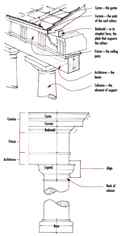
The study of the ancient elements of construction and how the fit together is called Tectonics.
Symmetry
In classical architecture, things are symmetrical (right/left) unless there is a very good reason for it not being. Where possible, the tops of windows should align horizontally. Often the tops of doors are also aligned with the tops of the windows, although occasionally you can deviate from that.
The Orders
Orders aim to categorize the different ancient architecture styles, eg column style, but many other aspects too. You will hear names such as Doric, Tuscan, Ionic, and Corinthian. Personally I like the Tuscan style (as pictured below) because it is the cleanest look and the simplest to implement.



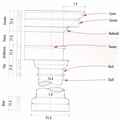
The Entablature (which is the Architrave+Frieze+Cornice) should have a height that is 1.75 times the column base diameter.
Column alignment
It is very important to get the column alignment correct. The edge of the top of the shaft aligns with the edge of the beam (Architrave) and the edge of the ceiling joists (Frieze).


Columns do not support the ceiling directly. Instead they support a beam (Architrave) that is what actually supports the ceiling joists (Frieze). The beam is likely to be somewhere between 8" and 12" tall.
When there are two stories of columns, the alignment must be as per the following drawing.

Railings above should also be aligned. It is good to try to make the railings seem lower than the 36" that building code requires. This can be done by including an additional horizontal rail that is 4" below the top rail. Also the bottom rail can be 4" above the concrete.

The front face of the Architrave should align with the edge of the top of the column.
Supporting decks as they attach to building
The front edge of decks are supported by columns, but visually the deck also needs to be supported as it attaches to the building. Either this needs to be an "engaged column" (round) or it needs to be a "Pilaster" (rectangular). Columns are the width of the tapered columns are project out between 5/8 and 3/4 of the column width. Pilasters are the width of the top of the column and project out from the wall between 1/5 and 1/4 of the column width.

Portico tops
A "Tetrastyle Portico" has four columns. It was often used by the Greeks and the Etruscans for small structures such as public buildings and amphiprostyles. The Romans often used the four columned portico for their pseudoperipteral temples like the Temple of Portunus, and for amphiprostyle temples such as the Temple of Venus and Roma, and for the prostyle entrance porticos of large public buildings like the Basilica of Maxentius and Constantine. Roman provincial capitals also manifested tetrastyle construction, such as the Capitoline Temple in Volubilis. The North Portico of the White House is perhaps the most notable four-columned portico (ie "Tetrastyle Portico") in the United States.
In a typical Roman temple, the area of the portico top (ie the Entablature and Pediment) is the same as the area of the columns.

The pitch of the Pediment should be between 21.5 degrees and 31.6 degrees. In the case of Roman architecture, the usual choice is 22.5 degrees. Personally I chose to use 30 degrees. The slope should be less than the roof (hip) slope. If the front door has a sloped cap then its slope should be even less.
You must use a "Raking Cyma". This basically means that the Cornice (Bedmold+Corona+Cyma) used on the horizontal is also used on the sloping roof. The sloping part protrudes forward due to it having the actual roof on top of the Cyma.
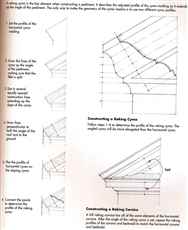
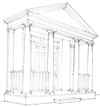
Create texture
Rather than a flat looking wall, it is good to make it more interesting. Useful concepts are using the texture of brick and making the windows be slightly inset. Inset windows take advantage of the walls being fairly thick (walls in the olden days were thick and ICF walls are also thick). If the walls look thick then it gives the impression of a substantial building. Even a 2" or 3" inset of the window relative to the wall face makes a lot of difference to the look. Window sills and visible lintels above windows also help create texture.
Windows
Windows should be taller than they are wide. Ideally they should have the glass divided into multiple panes (panes taller than they are wide). Personally I do not like false pane dividers so I opt for plain glass.

Always express a lintel above windows, particularly if the walls are brick.

In my case I chose to incorporate a 9" high lintel with a 4.5" overlap into the surround.
Doors




Wainscot
Inside the house it is good to put wooden wainscoting around the bottom
of the walls. The height of the top of the wainscot from the floor
corresponds to the height of the pedestal of a column that is the height
of the room. What this translates to is the following formula...
Room height in inches / 13 * 2.67 (and then round it down slightly).
My main floor has a ceiling height 12 feet which is 144 inches, so the wainscot should be 2' 5-1/2".
My bedroom ceiling height is 10 feet which is 120 inches, so the wainscot should be 2' 0-1/2".
My basement ceiling height is 14 feet which is 168 inches, so the wainscot should be 2' 10-1/2".
Reference examples
There are so any buildings where things have been done wrong that it is necessary to get back to the ancient Roman examples to be certain that you are copying the good stuff. The buildings that I regard as reference examples are as follows...
Pantheon (Rome)
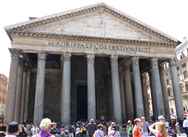


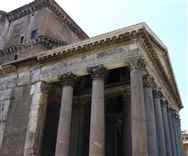
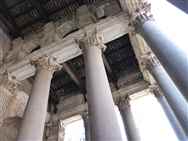
Temple of Portunus (Rome)

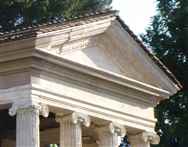
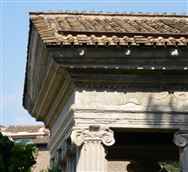
Parthenon (Athens)
Temple of Augustus
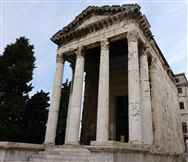

Good copy examples
Stowe (England)
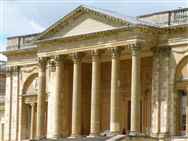

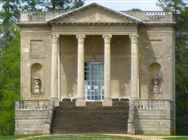
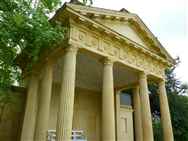
East London (England)
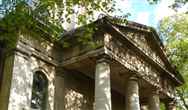
Veneto
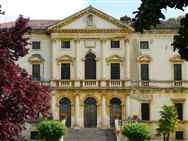

St Peter's Rome

My House Dimensions
Tuscan Order columns are plain (non-fluted) and taper for the top 5/7ths. The diameter at the bottom of the round column is 1/7th of the column height. The column height includes the base and top, but does not include the Entablature. The top of the column is 5/6th of the base diameter.




Some interpretation is required for a particular building. Here are the dimensions I'm using for my house. I use a spreadsheet to calculate everything.
*** Old version ***
Height Diam bottom-top
Sq Base Pre stucco
Bedroom level 9.5'
18" - 15"
24'-21"
14"
Main level
12.5' 22" - 19"
28"-25"
18"

Further reading
Andrea Palladio's - The Four Books of Architecture (Written 500 years ago)
Vitruvius - The Ten Books on Architecture (Written 2000 years ago)




